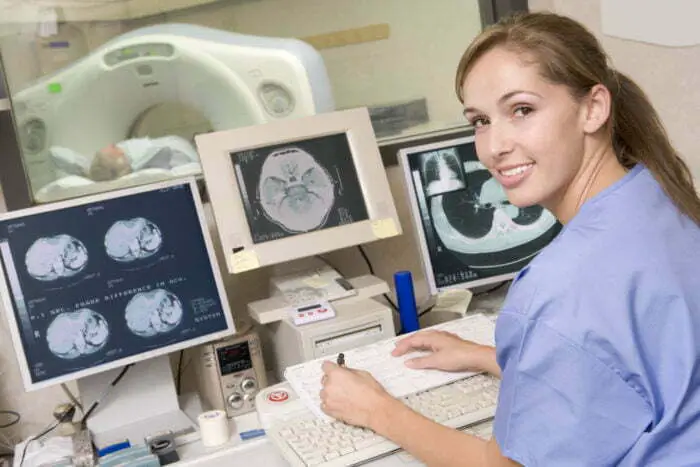MRI Vs. X-Ray: What’s the Difference?

When patients get injured or a doctor suspects something’s wrong with a patient’s body, imaging tests are requested to help diagnose the issue. But not all diagnostic imaging tests are the same. Here we explain what is MRI vs X-ray and also describe CT scans.
Magnetic Resonance Imaging (MRI) and X-rays are two of the most well-known imaging tests that doctors use for diagnosis. Both the tests produce images of bones, tissues, and other structures in the body.
However, different imaging tests use different technologies, reveal the inner parts of the body in different ways, and use different types of energy. Furthermore, not all imaging tests are equally accessible, and they provide different insights to doctors, which help identify specific medical complications.
Just like every imaging technology has unique uses and benefits, the risks are also unique. In this post, we’ve provided a detailed look at both MRI and X-Ray technology and compared MRI Vs. X-Ray to help you understand the differences between them.
We’ve also explained how a CT scan is related to X-ray imaging.
In This Article
What Is an X-Ray?
X-rays are the most accessible imaging exams. For this reason, doctors typically recommend getting an X-ray first, even if the patient may require a more sophisticated scan of a body part.
In this diagnostic imaging test, ionizing radiation is passed through the body. When the ionizing radiation hits calcium-rich bones and other dense objects in the body, the radiation is blocked there, and those areas appear white on the X-ray. When the ionizing radiation hits less dense tissues, they appear gray on the X-ray.
To get an X-ray image, the machine must be positioned over the area to be scanned. A radiology technician or X-ray tech positions patients appropriately for the machine to get a clear image. The patient must hold the position until the image is taken.
X-ray exams are some of the shortest diagnostic imaging tests you can take. They only take about ten minutes to complete. The images are printed on a photographic film and handed over to the patient to submit to their doctor.
When doctors need to see a joint’s soft tissue structures, a contrast dye is administered via injection into the joint. The dye also makes it easier for doctors to place a needle into a joint.
exams do. However, they’re the most common technique used for evaluating orthopedic issues. An X-ray exam is used to detect:
- Dislocations
- Fractures
- Narrowed joint spaces
- Misalignments
- Types of cancer
- Pneumonia
It’s important to remember that X-rays do not reveal soft tissue injuries, inflammation, or subtle bone injuries. However, doctors still use it to rule out a fracture, even if they detect a soft tissue injury.
Scanning the body with radiation exposure to view the internal parts isn’t very harmful. However, special precautions are taken to protect pregnant women and rad techs when taking an X-ray.
Types of X-Rays
X-rays are of two types: soft and hard.
Soft X-rays have short wavelengths of about 10 nanometers. For this reason, they can be placed between UV light and gamma rays in the electromagnetic spectrum.
On the other hand, hard X-rays have wavelengths that are 100 picometers long. So, these rays occupy the same area as gamma rays on the electromagnetic spectrum.
Pros of X-rays
- The biggest advantage of X-ray exams is that patients can get them at almost any medical facility. The exams are also affordable, making them accessible to all patients.
- Getting an X-ray image taken takes about ten minutes. Diagnosing the issue inside the body using the image is also a short process.
- A lot of cases are too urgent for a doctor to ask the patient to visit a hospital or outpatient facility for an MRI. X-rays are available at almost every doctor’s office, dentist’s office, and urgent care center. Therefore, requesting an X-ray is a faster way for doctors to make diagnoses.
Cons of X-rays
- There are some long-term risks of radiation exposure from X-rays. The risks are higher in individuals that often get X-rays and in children.
- X-ray images are flat and do not show the scanned area in multiple angles.
- X-ray images may not be safe for pregnant women, specifically around the abdominal and pelvic areas.
Learn more about how X-rays work.
What Is an MRI?
Magnetic Resonance Imaging (MRI) is a diagnostic imaging technique that involves using a powerful magnet to pass radio waves through the body.
The protons in the body react to the energy from the radio waves, which helps the machine create detailed images of the body. The images reveal soft tissues, nerves, and blood vessels inside the body. An MRI technician can take several cross-sectional images of the body in one exam with an MRI scan.
MRI scans do not use any radiation, which is a big plus. Doctors ask patients to get an MRI scan to assess bone and joint issues, determine if treatment is effective, evaluate brain abnormalities, and look into pelvic pain or issues with fertility.
MRIs can be used to take an image of any body part and provide a clear view of inside your body. For this reason, an MRI scanner can also be used to detect spine injuries, nerve compression, cartilage loss, and torn muscles, ligaments, or tendons.
Types of MRI Scans
There are seven different types of MRI scans:
#1 Open MRI Scans – High-Field (1.5T)
The machine is open on three sides in open MRI scans, providing the patient with roomy experience and allowing for bright imaging. The modern design of the machine makes the exam short and comfortable.
The “High-field (1.5T)” refers to the quality of the image. MRI machines with a 1.5T magnet come with various coil options, which makes for improved image quality across applications compared to 3T MRI machines.
#2 Short Bore Scans
The “bore” is the opening of the MRI machine. Short bore MRI scans are marginally wider and half as short as a conventional MRI scan. The smaller setup makes the patient’s experience roomy and airy.
#3 Open Bore Scans
As the name suggests, open bore scans provide a wider opening for the patient, making the experience much more comfortable. A traditional bore is only slightly bigger than the patient, making the experience restrictive and uncomfortable.
#4 High-Field (1.5T) MRI Scans
High-field 1.5T machines come equipped with the latest imaging technology. The new tech is valuable for doctors and enables them to scan all body parts.
#5 3T MRI Scans
The 3 Tesla MRI is an efficient yet powerful MRI machine mainly found at research centers. They have become more accessible to hospitals in recent years. 3 Tesla magnets are much more powerful than 1.5 Tesla magnets, which means 3T MRI machines capture images quickly and more clearly than 1.5T machines.
#6 MRI Spectroscopy
It is a non-invasive diagnostic technique that enables doctors to characterize tumors, infarcts, and other pathology. MRI spectroscopy is commonly performed to diagnose specific metabolic disorders. The technique enables doctors to detect specifics such as the tumor’s aggressiveness and metabolism.
#7 MRCP Scans
An MRCP scan is a type of MRI scan that helps capture images of hepatobiliary and pancreatic systems.
Pros of MRI Scans
- MRI scans capture several clear images in different views, allowing the doctor to make accurate diagnoses.
- MRI scans are preferred for patients that require imaging tests frequently since MRI machines don’t emit any radiation.
Cons of MRI Scans
- The machine is noisy during a test
- Machines are small and sometimes trigger claustrophobia in patients
- The bore may be too small for some patients to fit
- The machines don’t work if the patient has certain implants
- Are often the most expensive scan offered at any facility
- Cans take between 30 minutes to an hour
- In some circumstances, a contrast dye may need to be injected, which some patients are allergic to
How Much Do These Tests Cost?
The cost of an imaging test depends on many different factors, including the location and your insurance.
MRI Cost
MRI scans are the most expensive imaging tests, costing between $1,200 to $4,000. The type of medical facility you are at and the amount of time it’ll take to do the test are some factors that influence the cost.
X-Ray Cost
This type of imaging tends to be much cheaper, but the cost varies a lot more. An X-ray exam typically costs between $100 and $1,000. Some specialized exams cost $20,000. X-ray technology is widely accessible, making them cheaper than most other imaging tests.
MRI Vs. XRay: What are the Differences?
The differences between magnetic resonance imaging (MRI) vs. X-ray are significant.
X-ray exams:
- barge you with ionizing radiation, whereas MRI machines don’t emit any radiation.
- take about ten minutes, whereas an MRI scan takes up to an hour or more.
- provide a limited look at a few parts of the body.
- tend to be cheap, whereas MRI scans are among the most expensive medical imaging tests.
How is a CT Scan Different from an MRI and X-ray?
A computed tomography or CT scan is a diagnostic imaging test that uses X-rays and computer technology to produce a series of images. CT scans are different from MRI scans since MRI machines manipulate a magnetic field.
CT scans and CAT scans are used interchangeably and define the same imaging procedure. CAT scan stands for computed axial tomography.
CT scans are pictures that show very thin “slices” of your bones, muscles, organs, and blood vessels. Each CT scan makes it easier for radiologists and other healthcare providers to see sections of a patient’s body in fantastic detail.
The CT scan takes much longer to complete and costs more than a standard X-ray exam. Since the CT scan exposes you to ionizing radiation, these aren’t safe for frequent imaging.
Unlike traditional X-ray devices that use a fixed tube to direct rays at a single point on the patient’s body, CT scan machines rotate around the patient, 360 degrees, to capture detailed 3D images of the patient’s body.
A CT scan procedure is different than both an X-ray or MRI. The bed moves the patient into the doughnut-shaped CT scanner rather than the device being positioned next to the patient. The scanner takes pictures of the area the healthcare provider needs to see. Unlike an MRI scan, a CT scan is silent.
CT scans take about an hour to complete and 24 hours to get the results.
What’s a sonogram vs ultrasound?
The Takeaway
X-rays exams are faster and more affordable. However, these exams only offer images of bones and do not provide 3D images. Furthermore, X-ray exams expose you to small amounts of radiation, making them unsafe for long-term use.
MRI exams take longer to complete and are expensive. However, these exams provide images of tissues, muscles, and tendons at several angles.
Weighing the pros and cons of the two tests and factoring in the detail required in the image is the right way to determine which one is right for a patient.
Categorised in: Education
